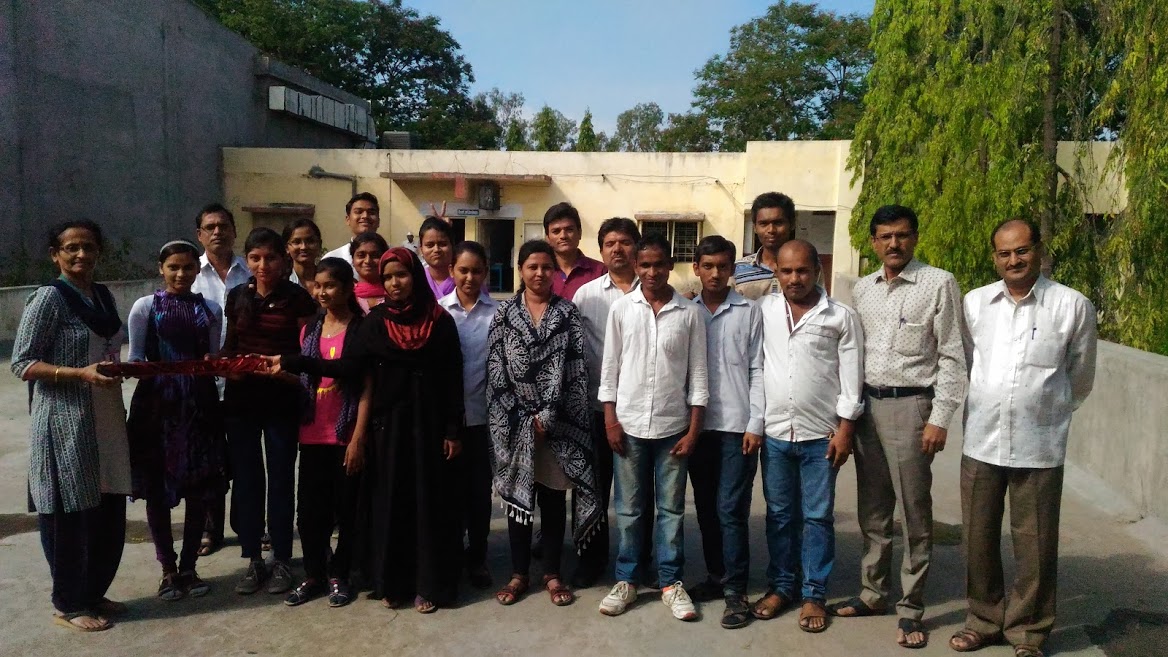Departmental Activity
Departmental Schedule
- Mon - Tues :
10.00 am - 05.00 pm
- Wednes - Thurs :
10.00 am - 05.00 pm
- Fri :
10.00 am - 05.00 pm
- 2'nd & 4'th Sat.
Open
- Sun :
Colosed

 About Department
About Department
| was set up in the year June 1997, with the objective of promoting specialized knowledge in the field of Science and Management Science. |
| Department works on developing strategy to provide, well-equipped laboratories, and industry oriented syllabus with add-on short term certificate courses which prepare the students for a best career in industry. Department is running under graduate Courses B.Sc. Optional Science, B.Sc. Science, B.C.A. Management Science. Department works on developing strategy to provide, well-equipped laboratories, and industry oriented syllabus with add-on short term certificate courses which prepare the students for a career in industry. |
 Syllabus
Syllabus
Teaching Syllabus
 Programme Outcomes
Programme Outcomes
PO-CO-PSO
| Course | Course Outcomes |
|---|---|
| Program Outcome : | 1) Critically evaluation of ideas and arguments by collection relevant information about the plants, so as recognize the position of plant in the broad classification and phylogenetic level.
2) Identify problems and independently propose solutions using creative approaches, acquired through interdisciplinary experiences, and a depth and breadth of knowledge/expertise in the field of Plant Identification. 3) Interpretation of collected information and use taxonomical information to evaluate and formulate a position of plant in taxonomy. 4) Students will be able to apply the scientific method to questions in botany by formulating testable hypotheses, collecting data that address these hypotheses, and analyzing those data to assess the degree to which their scientific work supports their hypotheses. 5) Students will be able to access the primary literature, identify relevant works for a particular topic, and evaluate the scientific content of these works. 6) Students will be able to identify the major groups of organisms with an emphasis on plants and be able to classify them within a phylogenetic framework. Students will be able to compare and contrast the characteristics of plants, algae, and fungi that differentiate them from each other and from other forms of life. 7) Students will be able to use the evidence of comparative biology to explain how the theory of evolution offers the only scientific explanation for the unity and diversity of life on earth. They will be able to use specific examples to explicate how descent with modification has shaped plant morphology, physiology, and life history. 8) Students will be able to explain how Plants function at the level of the gene, genome, cell, tissue, Flower development. They will be able to give specific examples of the physiological adaptations, development, reproduction and mode of life cycle followed by different forms of plants. 9) Students will be able to explain energy and nutrient flow through the environment. They will be able to relate the physical features of the environment to the structure of populations, communities, and ecosystems. 10) Students will be able to demonstrate proficiency in the experimental techniques and methods of analysis appropriate for their area of specialization within biology. |
| Diversity of Cryptogams - I B.Sc. FY (SEM -I) | Learn microscopic plants e.g. viruses, bacteria, algae and fungi. Importance in human life. 1. Understand the diversity among know diversity of Viruses, Bacteria Algae and their useful and harmful activities. 2. Understand the structure of Mycoplasma and its activities. 3. Know the systematic, morphology and structure, of Algae. Understand the life cycle pattern of Algae. 4. Understand the useful and harmful activities of Algae. 5. Understand the Biodiversity of Fungi 6. Know the Economic Importance of Fungi. |
| Morphology of Angiosperms B.Sc. FY (SEM -I) | Study of types of various organs of flowering plants |
| Diversity of Cryptogams - II B.Sc. FY (SEM -II) |
Learn first land plants groups e.g. Bryophyta, Pteridophyta. 1. Understand the morphological diversity of Bryophyta & Pteridophyta. 2. Understand the economic importance of the Bryophyta & Pteridophyta.. |
| Histology, Anatomy and Embryology B.Sc. FY (SEM -II) Electronics | Internal structure of plants. Types of tissue. Types of Embryo. 1. Understand the scope & importance of Anatomy. 2. Know various tissue systems. 16) Understand the normal and anomalous secondary growth in plants and their causes. 3. Perform the techniques in anatomy. Know the methods of pollination and fertilization. 4. Know fertilization, endosperm and embryogeny. |
| Taxonomy of Angiosperms B.Sc. SY (SEM -III) |
Studies on various important plant families with similar characters. Classification systems. Uses of plants in human life. 1. Know the conceptual development of taxonomy and systematics 2) Understand the Phylogeny of angiosperms -A general account of the origin of Angiosperms. 3) Understand the general range of variations in the group of angiosperms. 4) Trace the history of development of systems of classification emphasizing angiospermic taxa. 5) To learn the wide activities in angiosperm and trends in classification. 6) Learn about the characters of biologically important families of angiosperms. 7) Know the floral variations in angiospermic families, their phylogeny and evolution. 8) Understand various rules, principles. |
| Plant Ecology B.Sc. SY (SEM -III) |
To understand the nature of environmental influences on individual organisms, their populations, and communities, on ecoscapes (ecosystem) and ultimately at the level of the biosphere. Useful for the understanding of ecological concepts as well as the ability to apply ecological knowledge to manage and remediate environmental problems. |
| Gymnosperms and Utilization of plants B.Sc. SY (SEM -IV) |
Learn link of evolution between angiosperms and gymnosperms, structure. Use of plants in human life. 1. Understand the diversity of Gymnosperms in India 2) Know the evolutionary trends and affinities of living gymnosperms with respect to external and internal features. 3. Understand the role plants in human welfare. 4. Gain knowledge about various plants of economic use. 5. Know importance of plants & plant products. 6. Understand the chemical contents of the plant products. 7. Know about the utility of plant resources. |
| Plant Physiology B.Sc. SY (SEM -IV) |
To understand metabolism of plants by learning various physiological cycles. 1. Understand the Biochemical nature of cell. 2. Know the chemical nature of biomolecules. 3. Understand the different types of interaction in Biomolecules. 4. Structure and general features of enzymes. 5. Concept of enzyme activity and enzyme inhibition. 6. Learn about the movement of sap and absorption of water in plant body. 6. Understand the plant movements. 7. Understand the process of photosynthesis in higher plants with particular emphasis on light and dark reactions, C3 and C4 pathways. 8. Understand the respiration in higher plants with particular emphasis on aerobic and anaerobic respiration. |
| Cell Biology and Molecular Biology B.Sc. TY (SEM -V) |
Study of cell structure, functions of various cell organelles, Cell division, nucleic acid and chromosomes. 1. Know cell structure, prokaryotic and eukaryotic cell. 2. Structure and organization of cell wall and organelles. 3. Understand nucleus its structure and functions. 2. Know cell cycle, cell division-Mitosis & Meiosis and its significance. 3. Know organization of nucleic acid DNA, RNA and its functions. 4. Understand chromosome organization, chemical composition, giant chromosomes, aberrations and its functions of chromosomes. |
| Diversity of Angiosperms - I B.Sc. TY (SEM -V) |
Studies on various important plant families with similar characters. Classification systems 1. Know the concept of methodology in taxonomy. 2. Learn about conservation of biodiversity, major causes for loss of biodiversity and conservation measures. 3. Discover botanical regions of India and vegetation types of Maharashtra. 4. Understand Bioremediation, Global warming and climate change. 5. Studies on phyto-taxonomy and angiosperms families. |
| Genetics and Biotechnology B.Sc. TY (SEM -VI) |
. 1.To demonstrate the ability to design creative solutions to real life
problems faced by the industry. 2. Develops the use of the C programming language to implement various algorithms, and develops the basic concepts and terminology of programming in general. |
|
Diversity of Angiosperms - II B.Sc. TY (SEM -VI) B.Sc. TY (SEM -VI) |
Studies on various important plant families with similar characters. Various classification systems. 1) Know the conceptual development of taxonomy and systematic 2) Understand the Phylogeny of angiosperms -A general account of the origin of Angiosperms. 3) Understand the general range of variations in the group of angiosperms. 4) Trace the history of development of systems of classification emphasizing angiosperm taxa. 5) To learn the wide activities in angiosperm and trends in classification. 6) Learn about the characters of biologically important families of angiosperms. 7) Know the floral variations in angiosperm families, their phylogeny and evolution. 8) Understand various rules, principles and recommendations of plant nomenclature produces in plant identification. 9) Understand major evolutionary trends in various parts of angiosperm plants |
 Teaching Staff
Teaching Staff
About Our Staff
| Sr.No. | Faculty Name | Qualification | Designation | View Profile |
|---|---|---|---|---|
| 1 | Dr. V.C. Khilare, Professor | M.Sc.(Botany) | Professor & Head | Click Here |
| 2 | Dr. M.P. Kulthe | M.Sc.(Botany) | Asst.Prof. | Click Here |
 Activity
Activity
Departmental Activity
Yearwise Departmental Activity Science VNM-Abad
![]() :
Activities for the Year 2019-2020
:
Activities for the Year 2019-2020




 B.Sc. Science (Botany)
B.Sc. Science (Botany)











